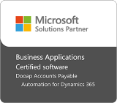
Same day ACH and real-time payments are the rage right now in the payment industry. But, for a business to unlock the real benefits of faster payments, they must have the right key – electronic invoicing. E-Invoices, on average, are ready to be paid 12 days sooner than paper invoices, providing opportunities for a business to develop working capital strategies that can utilize faster payments more effectively.
Disclaimer: Todd M. Albers is a senior payments consultant in the Payment, Standards, and Outreach Group at the Federal Reserve Bank of Minneapolis. He is the convener of the Business Payments Coalition e-Invoice Work Group and can be reached at todd.albers@mpls.frb.org. The opinions expressed in this blog post are those of the author, and not those of the Federal Reserve System or the Federal Reserve Bank of Minneapolis.
In addition, there are many other benefits including fraud detection, visibility into liabilities to better manage cash flow, early payment discounts and other strategic payment practices.
It’s easy to see the benefits of e-payments. They enable faster payments, and minimize fraud and errors, while saving time. And it’s something that we’ve grown accustomed to as consumers as we shop online or at brick-and-mortar, use PayPal or other services to buy tickets or other items, and even pay our utility and other monthly bills electronically. A whole industry has sprung up for mobile B2C payment with services such as Apple Pay, Google Wallet and even C2C payment with services like Venmo.
While e-payments for B2B in the U.S. hasn’t quite caught up to the popularity consumer applications – or to European practices, where checks are practically unheard of – it is gaining momentum. The processes and programs that support technologies such as virtual card payments are a driver behind the growth of B2B e-payment in the U.S. Buyers are being offered incentives to engage their suppliers in accepting these payments, and if they do not want to do so, then at least accepting ACH payment. This supplier engagement has opened the door for card issuers and payment service providers to collect information from millions of touchpoints, creating the foundation for electronic payments.
And it seems to be working. The Association for Financial Professionals recently conducted a survey that uncovered that B2B check payments in the U.S. had a significant drop from 51-42% in a three-year timeframe. It’s no wonder, when you consider that, in addition to reduced fraud and increased efficiency, electronic payments are significantly cheaper than check payments – the difference between pennies for an ACH payment vs. about $5 to create and issue a check.
Despite these benefits, there are several barriers impeding the adoption of electronic payments:
- Reluctance to share banking info on an invoice. Some U.S. companies just don’t feel comfortable sharing their banking information, such as routing and account numbers, on their invoices because they perceive that it could lead to fraudulent practices. But in reality, that shouldn’t be of concern thanks to stringent banking controls to safeguard unauthorized withdrawals from bank accounts. And, in any case, routing and account information is readily available anyway; that information is right on every check that a business issues.
- Paper invoicing and remittance process. Paper invoices are a barrier to electronic payment. When companies receive an invoice in paper format they have to scan or input all the invoice information into their system manually to turn it into an electronic format. Even when this information is converted to an electronic format – which takes additional time, resources and cost – it is not as accurate as invoices that are sent electronically in the first place.
- Not all trading partners or banks are equal. Smaller organizations often don’t have the same AP or payment automation capabilities as their larger counterparts – or if they do, it’s often cost prohibitive, making it harder for them to access payment systems.
E-invoicing Lags E-payment
The U.S. is incentivized by greater efficiencies and reduced costs in the private sector, while European e-invoicing is being driven by governments in their mission to create a single market to drive efficiencies and, in some cases, to ensure tax compliance and collection.
It’s understandable that e-payment adoption has moved faster than e-invoicing, in large part because the process is easier. While automating payments typically requires sending just one file to the payment provider or bank, e-invoicing is dependent on the many systems and file formats that can be received from various suppliers, although now there are solutions available in many markets that effectively address this issue. Additionally, because the e-invoicing process is more involved, there may be more of an initial cost barrier for SMBs, but the efficiencies gained through e-invoicing can offset these costs many times over.
The good news is that the Business Payments Coalition (BPC) is focused on addressing these problems to make it easier and cost-effective for all organizations to implement e-invoicing. The BPC is working on standardizing invoices, including: what an invoice is, what is in it, and the file format and method in which it is sent. By addressing the complexity issue, standardization will drive down the costs for all parties, making it much more attractive and accessible to all organizations, including SMBs.
E-invoicing and Invoice Automation are Critical to Furthering E-Payment
Purchase-to-pay is an end-to-end process so it’s not enough to just fix one part of it. To gain true business advantage the whole process needs to be automated. If companies just conduct invoice automation without e-invoicing, it still takes time and resources to get the invoices into the system – and of course, that introduces the possibility of error. And, e-invoicing and invoice automation are critical for reducing payment fraud, and enabling more accurate e-payment. Consider that today, 42% of paper invoices are paid on the time, regardless of the payment method. When companies implement e-invoicing and invoice automation, that amount goes up to 95%. Consider that once an e-invoice is in the system, it takes approximately 3-4 days for it to be readied for payment, while paper and PDF invoices take about 15 days.
In addition to increasing on-time payments, the visibility that e-invoicing gives organizations into spend greatly increases their ability to develop working capital strategies and take advantage of cash discounts.
So how does e-invoicing lay the groundwork for more strategic payment practices? And, how does it help promote further digitization trends, such as analytics and AI in 2020 and beyond? Stay tuned for part two of this blog that will address my perspective on these topics as we look toward the new year and decade.








